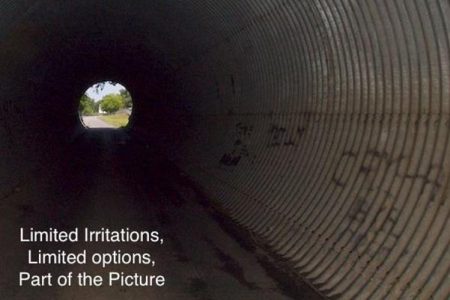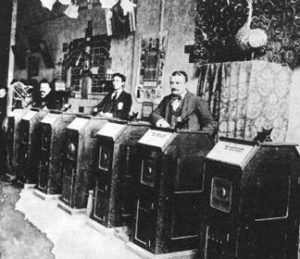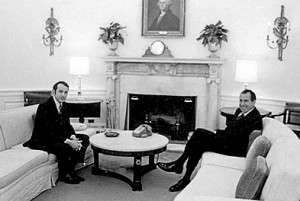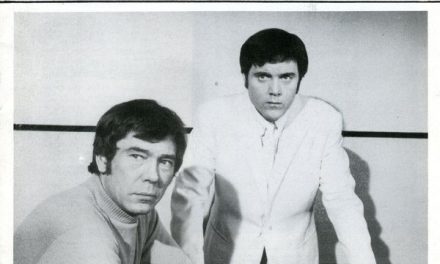First of all, let me start with a personal note. I am a compulsive organizer. My desk space in reality may not demonstrate this, but my actual (!) desktop, the real one I use disconnected from any material spaces is VERY neat. Just a handful of folders on either side of an artistic drawing of a lady with a TV for a head. There is a weekly routine: everything of personal, scholarly or pedagogical interest is directly added to tabs or the reading list. Then every other week I’d click through to identify what was outdated (delete), what will be PDFed (then added to the desktop), and what should be added to bookmarks (equally organized into folders, including: research, resources, student materials etc.). Sitting down last week to organize my thoughts on this article here I was struck by the vast amount of sub-folders, and quickly, my plan to write about nostalgia, elite transcultural audiences, and new narrative design in television morphed into something else. Divvied up in myriad ways depending on predominant (and sometimes secondary) subject centres, there is a problem with my organizing tick that presents itself more readily in data, than it would on paper.
The entries in my folders, as the elements to be considered in my research, they overlap, intermingle and create a web-works of meaning, and generate a real and readable footprint, one that is becoming less visible, however, obscured by my folder-making, less clear by applying focus. The abundance of information and vantage points available, the wealth of interdisciplinary engagement now rendered an organised and yet disconnected data set. Where, to say it in David Levente Palatinus’ words, my “organizing practice should result [only] in a more readable and more ‘organic’ data flow that displays both demarcatable subsets or clusters as well as continuity” but then it highlighted a wider issue: categories. Boxes. Lenses (with shallow focus). Ones and Zeros. The best of much of our scholarship is excelling in focus, but lacks the infrastructure[i] to correlate across this vast information. Needless to say, someone has to generate the specific data for someone to read the overlaps, but by and large, and no matter the claims for interdisciplinarity, most of us feel best in the tunnel systems we know. Computational video analysis, coding help, scholarly online communities and publishing spaces, multi-medial critical and academic engagement, they are all evidence that we as a field are moving and changing and redrafting our own value system, but even here a certain focus is not only deemed necessary but valued.
Add to this an established and internalised debate of value and hierarchy, and we arrive at legitimacy debates of our work, that limit it further, especially, where non-star researchers are concerned whose existence relies on legitimacy. To clarify, academic-casual (twitterverse and co. – smart people say smart and informed things), academic-journalistic/professional (academic blogs, see Redef.com and The Conversation, and classically structured spaces like CST Online), trade-journal content and research based upon it, and academic work proper, the kind which is found in articles[ii] and in books[iii] are not created equal. But, as the above engagement shows, much of contemporary debate is located elsewhere and productivity thrives outside the system-value-chain and renders some of these borders less relevant by their very nature.[iv]
This means work such as mine is flexible, and unapologetically unfocused. My research-reads folder contains many subfolders that focus on that pesky entity Netflix, a service provider, later specialising in SVOD offerings, before utilising and elevating (really) data mining/generation to an artform and potential business strategy. The company is currently investing heavily in its production studios arm with production sites in New York, Mexico City, Paris, Madrid, London, Liverpool (forthcoming) and elsewhere, and thereby is increasing its push to break the “concept of territoriality” so instrumental to television production and trade practices up until now (Green, 2019). Considering classic definitions of technology, identifying technology as the knowledge of methods, devices, systems to, simply put, change life as we knew it before, then we can say that Netflix, among other things, is:
A TV network, a production studio, content creator, data company, technology firm, software company, SVOD platform, (you may add-on your vantage specific identifier here, this list is not exhaustive) _______.
Scholars have been falling prey to the myth making machine of Netflix, as have I. It offers a rich side of study, albeit never having written black numbers and as a business model in dire need of overhaul, if it is to prevail in the shakeout phase of streaming services that is upon us. But more so than being trapped by Netflix’s brand activation tactics, Netflix IS evidence for the larger changes ongoing and, by its very nature as non-singular entity,[v] provides a multitude of access points to media scholars, no matter their discipline, background, or media experience; media industry scholars, narratology researchers, cultural studies and television studies academics, socio-politically inclined colleagues as well as behavioural scientists, sociologists, film scholars[vi] and more, they all find a wealth of study material. What falls by the wayside is a study of the ecosystem within which all these boxes, foci, and access hatches exist, not just for Netflix, but the media environment; an acknowledgment and study of the beautifully intertwined intersections of change, if you so will: that which drives human storytelling in a capitalist digital reality. This speaks to a post-digital line of questioning: where do we stand in this world, where does our culture live, expand, take shape?
The circuit’s nodes and connectors that generate affect and steer behaviour, that enable de- and re-habituation, which I’ve talked about elsewhere, are problematic to study because they, matter of fact, are continually in motion. We may not like it, but Netflix sits at the heart of this moment and with its micro-markets, no matter how insignificant overall subscriber numbers globally may be, offers a worthwhile snapshot precisely because so many of us interrogate its dimensions. It allows us to reflect on motion, draw conclusions, and project momentum, if you so will.
Walter Benjamin quotes Paul Valéry in the opening to his seminal […] Work of Art in the Age of Mechanical Reproduction (1936):
“Our […] arts were developed, their types and uses were established, in times very different from the present, by men whose power of action upon things was insignificant in comparison with ours. But the amazing growth of our techniques, the adaptability and precision they have attained, the ideas and habits they are creating, make it a certainty that profound changes are impending in the ancient craft […].”
Granted, you’d have to imagine Reed Hastings, Netflix’ CEO, speaking, but these words from 1931 could very much apply to Netflix’s understanding of itself as television, its position in the world and in relationship with the audience. The company is itself experiencing a challenging time, as NBC, Warner Media, and Disney (including its holdings – Marvel, HULU, Fox Studios, Star Wars, Pixar…) all are in the process of ending their license agreement practice with the SVOD brand for the sake of their own streaming platform establishment (Anderton, 2019). So it pays to take a closer look at an example of a true Netflix Original[vii] to identify some of these nodes, the changing processes and discuss their potential across a variety of study bodies:

Image 2: One Day at a Time (Framke, 2019)
The company cancelled its acclaimed series One Day at a Time (ODAAT). This was after a growing fandom had saved and brought the series a third year on the platform and viewer numbers had grown, but, for Netflix’ business model, the scales had tipped the wrong way. The ensuing debates from fans, critics, and academic viewers alike swallowed up in the news of more cancellations and a somewhat surprising, at first, revelation, that most Netflix and likewise other SVOD originals are having a hard time seeing a fourth season come to light. The business realities of cost+ finance models, increasing bump-pays, and viewer data indicating that long running series are not often enticing subscribers to join late, are all laid out nicely in a recent piece by Nellie Andreeva for deadline.com. It is important to note here that some people discuss this with a more emotional framework, stating that talent will move away from the platform, that audiences will, too. But, cancellations based on a show’s demise have yet to be noted by the company’s researchers and thus I think there is a different issue at hand here, that of audience expectation, trained by U.S. television, and too often discussed, solely, by US trade journals. Seeing that Netflix subscribers are just as much located outside the States as within, and with research only spot-lighting textual analysis or individual national production markets at this time, we get a skewed idea about such audience perceptions and practices. US television is master of the perpetual middle as had been noted in works by Christine Becker and Jason Mittell amongst others. British TV, by comparison, is not only good at concluding their television serial narratives, but maintaining appeal for talent and audiences likewise, with short runs and limited episodes.
This would indicate that what was built on US television practices, in production, distribution, and reception, is morphing to adhere to meet its own rationale and research. Netflix, in its global efforts, has identified as appropriate a different serial strategy and therefor may produce American television content without the US American rhythmic heritage. The company has mentioned a focus from hereon out on three season deals, which may bring about scripted endings or at least intended final episodes for stories told, rather than perpetual middles that ensure the hike to 100 episodes ready for syndication windfall. Andreeva sees “50 as the new 100” here.
Now, aside from opportunities to look into this from a media industries’ side, apply a narrative research angle, study the effects on the production environments and viewers depending on cultural expectations (from local to Netflix global) inherent in this shift, we can also interrogate the technological and digital dimensions of this, because, you guessed it, Netflix bases much of their decision making, including identifying that thirty episodes across three seasons is the ‘sweet spot’ for driving subscriptions, delivering coherent narratives, and maintaining audiences while optimising profit on data sets. This data is generated by the algorithms and data sciences department.
In a recent interview with Stanford University’s Margot Garrison, Caitlin Smallwood, Netflix VP of Data Science and Analytics discussed prediction models and communicating as data scientist to the executive board, ensuring they understand and see the value of data sciences in not only driving customer sign-up, but, customer satisfaction. She stated that she learned that she should always “double down on the point that we aren’t trying to automate any creative decision making,” because she understands that creatives need the freedom to tell their stories. But, her discussion of data sources, deep learning and potential for unlabelled data mining, belies that statement. The statement itself signals a concern amongst the executives/creatives already. Data science for her department at least, clearly is at the forefront of production efforts and the ongoing studio build (and its logistics), as are optimising automated localisation practices (such as translations for subs and dubs), and editing processes, including cutting trailers based on computational analysis of the video source (film or series). Smallwood places such scientific achievement firmly in the future, and her excitement is contagious, but, it begets questions not only for creative freedom, but cultural capital, cultural traditions, and storytelling at large, that tap into the realm of technological determinism and potentiality, of digital humanities and the effects tangible on our lived experienced in a[viii] creatively automated environment foreshadowed here.
She clearly is in step with the company agenda, and her comments represent the same notions we find in online brand ‘personae’ for Netflix such as on LinkedIn, Twitter, and other social media sites and feed my own research focus[ix] (on transculturality as brand)[x]. She states that the algorithm is tailored to reward subscribers, but that she is fascinated by:
“the broader global mission of helping the world understand regions around the world and cultures around the world through the innocuous platform of storytelling, because [she] think[s] it is really something that is so much more subliminal, something that can build global empathy.” (WiDS, 2019)
But, while this may be true, in a soul-communism sort of way, cancelling a show that was so full of empathy, love, cultural understanding and hope as ODAAT and one that had not lost its following but instead increased its fan base steadily, seems contradictory to that company ethos. But Netflix is not really on a mission of connecting people, and it was never built on classic notions of TV distribution. Netflix is focused on subscribers, new subscribers, those who may sign up for a series they heard about and want to get into for example.[xi] Data suggests that the new and shiny is of more interest for new-signers than shows with a substantial running time established.
To say it in classic terms, rerun channels are rerun channels…and we again are at a certain level of expectation. Matt Zoller-Seitz in a recent article on the impending ending of Game of Thrones discusses the end of an era, if you so will, of televisual togetherness, or, as he calls it, “maximum TV-ness.” He points at our understanding of television and sees it as being something shared, something experienced together, identified also in debates of television’s definition today by scholars such as Chuck Tryon or Amanda Lotz, and by a recent study conducted for TAMireland, as a relevant and essential need identified by viewers. But, what does togetherness mean? How do we bracket and categorize eras? Golden Ages, Peak TV moments, Creative Abundance,… if nothing else they exemplify that nothing is new, nothing truly ends, and we are in a cyclical motion where media is concerned, where there are always new and attention demanding evolutions, that come to their own end which forms a new beginning. Where experiences and engagement practices are concerned we have seen individual screenings before, at the very beginning, really, but until it became financially and logistically feasible, it was, really, only shelved.
Togetherness as a traverse experience might be a better way to think about this and frame our interrogations. We already moved away from a physical togetherness in many ways, such as the watercooler talk scenario, when experiencing a short era of live-tweeting and hashtag event scheduling, as with Pretty Little Liars. This leaves a certain understanding of simultaneity that stands in for ‘togetherness’ BUT, our practices, cultural moments, are they really predicated on simultaneity and ‘hit shows’ or on moving through experiences, and evolving with the media that surrounds us, and potentially, our scholarship can benefit from traversing, in an unfocused manner also?
Never mind that in my group of ca 280 students I teach this year I can count GoT watchers on two hands. It seems to me that Netflix is more reliant on new-ness to generate togetherness and accepts the short-lived pace of media existence we have all come accustomed to and which may be forced in part by the seasonal drop of Netflix shows, where the yearning and the excitement for the next instalment of serial content is no more a slow drip, but instead a yearly cliff-hanger finale for a week of joy. This is where we spent more time nostalgically looking back at the joy of seeing something for “the first” time, than experiencing it. In all the talks of demise of ODAAT I found no mention of “the years I invested,” because while the time spent is similar, the experience of time is not. And when others join the party late, we can hear our own elite-ness speaking for having seen it first, and maybe there is nothing new under the sun, but I am questioning how and by whom our stories will be told in the future, and how we will value our engagement with them.
I think the answer lies somewhere in the process of getting there, I think we need to be mindful of the myths that ever-better advertising create and question the rhetoric offered for our daily use by the subjects of study, and we must rally around cultural moments not because they are in, or offer a detail of interest, but because they offer and opportunity to study the systems, theirs and ours. So when I organise my files, I identify clusters, but I see connections, I move and duplicate into boxes, but I build a path, a way to move between the disparate elements that together form the human media experience, maybe not yet; it is a work in progress.
Bärbel Göbel-Stolz is a Senior Lecturer at Coventry University in the School of Media And Performing Arts. Her work focuses on Transnational transcultural media exchange and media industries‘ logics. She has recently published on audience hierarchies in a post-digital world and gendered television branding.
Footnotes:
[i] …if it does so as a field/practice/tradition, I couldn’t say.
[ii] …now getting better at turnaround if I may say so.
[iii] … yeah… the appropriateness of turnaround to subject here and the thereby faulty judgement of value in the academic sector is a different blog, I believe.
[iv] …if we ignore hiring, promotion, REF and other institutionalized identifiers of academic quality.
[v] …yes though the Twitterverse spends quite the time on discussing what Netflix is and therefore what it is not…
[vi] Another debate, yes.
[vii] We need to all be mindful not to copy Netflix’ approach to the term ‘original’ here, for more see this inciteful seven part series by Matthew Ball.
[viii] – Sorry Caitlin Smallwood.
[ix] Which inevitably exists.
[x] Across all global media players, not solely Netflix.
[xi] Critical acclaim needs award merit it seems.







